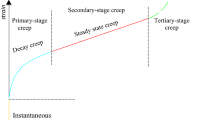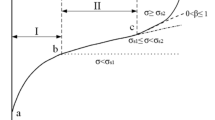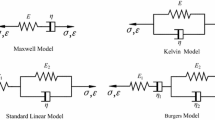Abstract
Nishihara model is modified by using unsteady viscous body. By combining with Lade–Duncan criterion, this study analyzes the whole deformation process of surrounding rocks of tunnels at visco-elastic and plastic stages and calculated visco-elastic–plastic solutions for surrounding rocks of tunnels. By taking an expressway tunnel as the research object, the displacement of surrounding rocks in creep aging process is calculated and the creep deformation of surrounding rocks of the tunnel is measured by monitoring vault settlement on site. By comparing theoretical calculation value with field measured value, it is verified that the theoretical calculation is correct. The theoretical calculation shows that when t = 0, creep phenomenon occurs to surrounding rocks and the displacement of surrounding rocks is 17.890 mm. When t is a constant, displacement of surrounding rocks gradually increases with time. While t = ∞, surrounding rocks are completely crept and the ultimate displacement of surrounding rocks reaches 26.451 mm. The monitoring results on site demonstrated that the first stable accumulative deformation of vault of surrounding rocks was 19.1 mm. After entering into creep stage, the second stable accumulative deformation of vault was 29.3 mm. The error between theoretical calculation and actual monitoring result of initial creep deformation is 6.76%, while 10.77% of error is found between theoretical calculation and actual monitoring results of final creep deformation. The small errors between them reveal that theoretical calculation shows a high accuracy. Theoretically, deformation of surrounding rocks increases by 47.85% after considering creep effects. Actually, the deformation of surrounding rocks rises by 53.4% after taking creep effects into account. This reflects that creep effects play an important role. Therefore, as for the support design of tunnels in soft rocks, creep effects are bound to be taken into consideration to avoid failure of primary supports caused by creep effects of surrounding rocks at later stage and then influences on overall stability of the tunnel.




Similar content being viewed by others
References
Briffaut M, Benboudjema F, D’Aloia L (2016) Effect of fibres on early age cracking of concrete tunnel lining. Part II: numerical simulations. Tunn Undergr Space Technol 59:221–229
Carranza TC (2003) Dimensionless graphical representation of the exact elasto-plastic solution of a circular tunnel in a Mohr-Coulomb material subject to uniform far-field stresses. Rock Mech Rock Eng 36(3):237–253
Лияцнцoфy HИ (1956) Elastic–plastic theory. In: Du Q et al (ed) Translate. People’s Education Press, Beijing
Hoek E (1990) Estimating Mohr–Coulomb friction and cohesion values from the Hoek–Brown failure criterion. Int J Rock Mech Min Sci Geomech Abstr 27(3):227–229
Hoek E, Carranza-Torres C, Corkum B (2002) Hoek–Brown failure criterion-2002 edition. Proc NARMS Tac 1:267–273
Küpper M, Wurm G (2015) Thermal creep-assisted dust lifting on Mars: wind tunnel experiments for the entrainment threshold velocity. J Geophys Res Planets 120(7):1346–1356
Liu X (1994) Fundamentals of rock rheology. Beijing Geological Publishing House, Beijing, pp 19–56
Ministry of Transport of the People’s Republic of China (2009) JTG F60–2009, Technical specification for construction of highway tunnel
Pan Y, Zhao GM, Meng XR (2011) Based on Hoek–Brown, a strength criterion of roadway surrounding rock elastic–plastic study. J Eng Geol 12(5):637–641
Peng R, Meng XR, Zhao GM (2014) Hoek–Brown criterion solution of circular roadway with considering intermediate principal stress. J Saf Sci Technol 10(1):11–17
Rao PP, Zhang CG, Song ZQ (2013) Rock resistant coefficient in tunnel based on Lade–Duncan failure criterion. J China Coal Soc 38(6):982–986
Shrestha PK, Panthi KK (2015) Estimating tunnel strain in weak and schistose rock mass under a state of in situ stress anisotropy. Hydro Nepal J Water Energy Environ 16:7–13
Sofianos AI, Nomikos PP (2006) Equivalent Mohr–Coulomb and generalized Hoek–Brown strength parameters for supported axisymmetric tunnels in plastic or brittle rock. Int J Rock Mech Min Sci 43(5):683–704
Sun J (1999) Rheology of geomaterials and its engineering application. China Architecture and Building Press, Beijing, pp 15–42
Tu ZR, Sun J, Cai XH (2006) Researchers on calculation methods of rock resistant coefficients of submarine tunnels. Chin J Geotech Eng 28(8):1002–1007
Xiong LX, Yang LD, Zhang Y (2010) Non-stationary Burgers model for rock. J Central South Univ (Sci Technol) 41(2):679–684
Zhang XB, Zhao GM, Meng XR (2013) Elastoplastic analysis of surrounding rock on circular roadway based on Drucker–Prager yield criterion. J China Coal Soc 38(s1):30–37
Author information
Authors and Affiliations
Corresponding author
Rights and permissions
About this article
Cite this article
Zhang, B., Hu, H., Yu, W. et al. Timeliness of Creep Deformation in the Whole Visco-Elasto-Plastic Process of Surrounding Rocks of the Tunnel. Geotech Geol Eng 37, 1007–1014 (2019). https://doi.org/10.1007/s10706-018-0668-7
Received:
Accepted:
Published:
Issue Date:
DOI: https://doi.org/10.1007/s10706-018-0668-7




